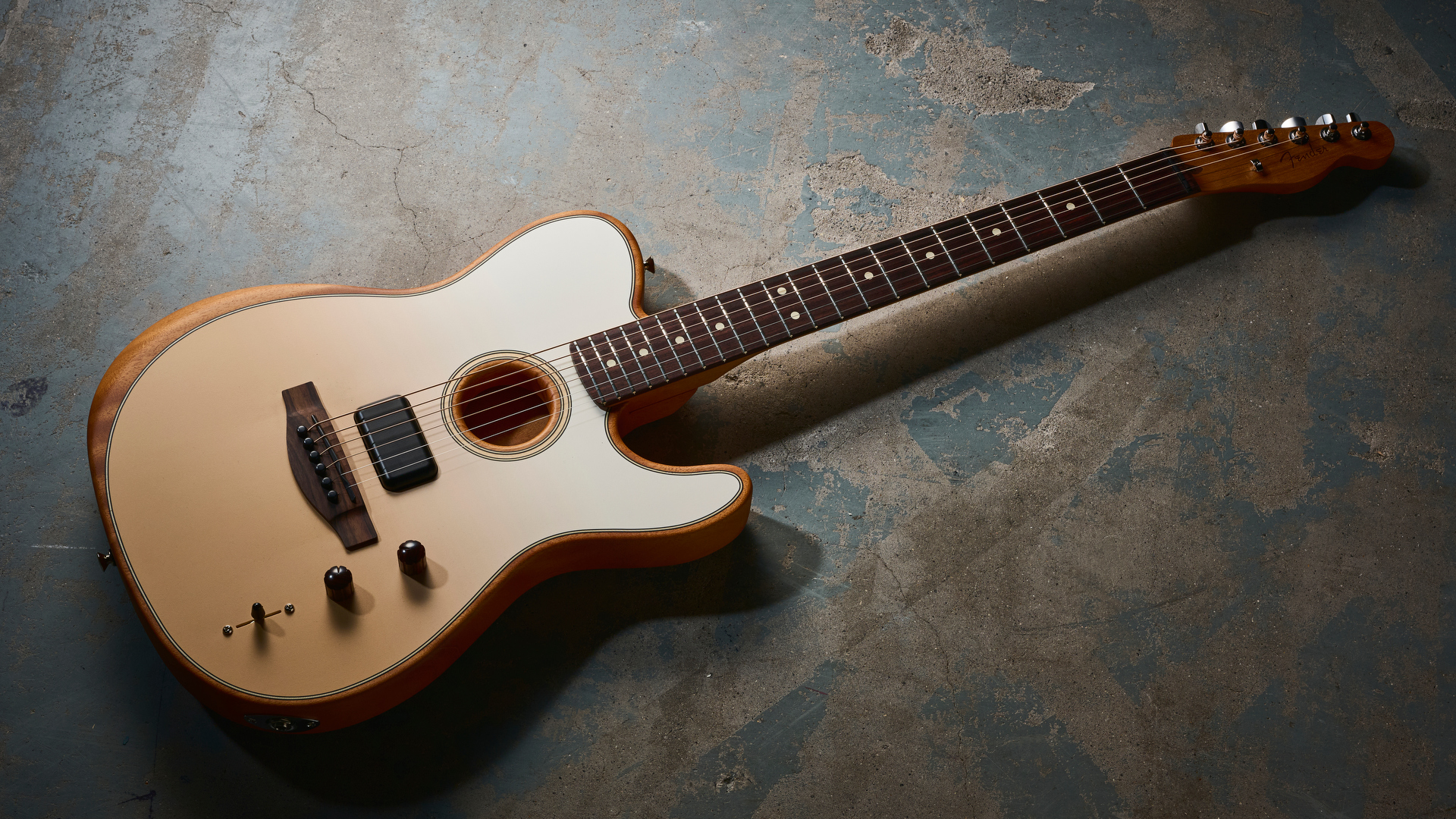
Fender Finneas Acoustasonic Player Telecaster: Need to know

A signature Acoustasonic?
This is Fender’s first Acoustasonic signature model, and the first to offer an onboard effect. While many players might assume that the Acoustasonic is a hybrid electric and acoustic guitar designed primarily for live use, Finneas O’Connell – collaborator/producer/multi-instrumentalist with sister Billie Eilish and now solo artist too – has praised Fender’s acoustic-electric guitar as a go-to studio instrument. And Fender has now decided to recognise his loyalty to the hybrid guitar cause with the FINNEAS Acoustasonic Player Telecaster.
How is this model different to the standard Fender Acoustasonic Player Telecaster?
Apart from the new Cappuccino Fade finish, the key differences here are a Tim Shaw-designed Shawbucker magnetic humbucker instead of the usual single-coil found on the regular Acoustasonic Player Telecaster. The addition of a blend-in chorus effect for two of the guitar’s six different 'voices' is surely the biggest news of all here. For this, something has to give, and it’s the standard Player’s ‘Lo-Fi Clean and Crunch modes from the ‘unaffected’ piezo’.
But doesn’t this guitar have an undersaddle piezo too?
It does, or a ‘transducer’ as Fender describes it in the manual. But like previous Acoustasonics, the piezo is used in combination with a kind of modelling / imaging for acoustic voices that are based on the miked sound of traditional acoustic shapes and woods (like a mahogany dreadnought).
Here we’re offered three of those voices, instead of the usual two and it’s this feature, along with the chorus effect that will be the real decider for non-Finneas fans choosing a Player Acoustasonic model. Here's how the six different voices on this model line up, with the guitar's blend control allowing you to choose between them, or mix the sound together:
Position 1 (Shawbucker): Clean Electric with blend Chorus – Clean Electric
Position 2 (Piezo): Rosewood Dreadnought acoustic – Mahogany Small Body acoustic
Position 3 (Piezo): Mahogany Dreadnought with Blend Chorus – Mahogany Dreadnought
Fender Finneas Acoustasonic Player Telecaster: Specs
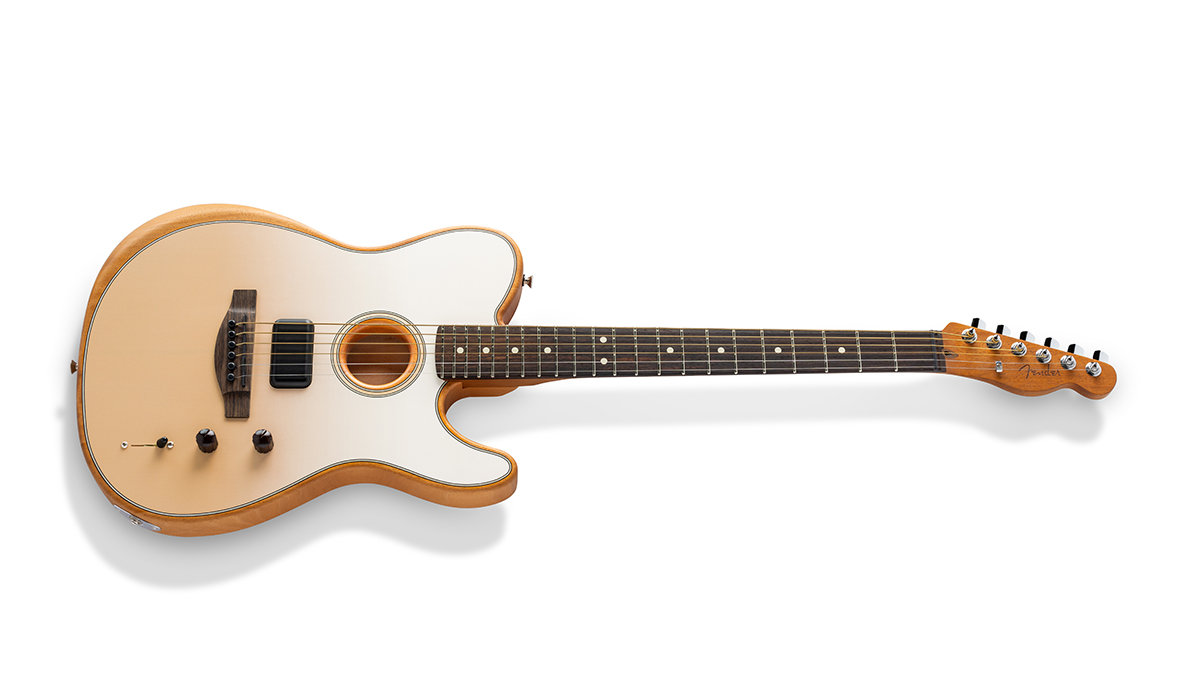
Launch price: $1,400/£1,199/€1,399
Made: Mexico
Body top: Solid Sitka spruce
Back & sides: Solid mahogany
Neck/shape: Mahogany/ Modern 'Deep C' / Satin urethane finish
Scale/length: 25.5" (644mm)
Nut/width: GraphTech Tusq / 1.6875" (42.86 mm)
String spacing at bridge: 52.5mm
Fingerboard/radius: Rosewood/12"
Body dpeth: 45mm
Finish: Cappucino Fade
Bridge/pins: Rosewood/GraphTech Tusq
Tuning machines: Fender Standard Cast/Sealed Staggered
Controls: Master volume, Blend, 3-way selector
Electronics: Under-saddle piezo, N4 Magnetic Acoustasonic Shawbucker
Weight of test model: 5lbs/2.26kg
Case: Deluxe 1225 Gig Bag
Left-handed options: No, only the (discontinued) American Acoustasonic Telecaster
Contact: Fender.com
Fender FINNEAS Acoustasonic Player Telecaster: Build quality
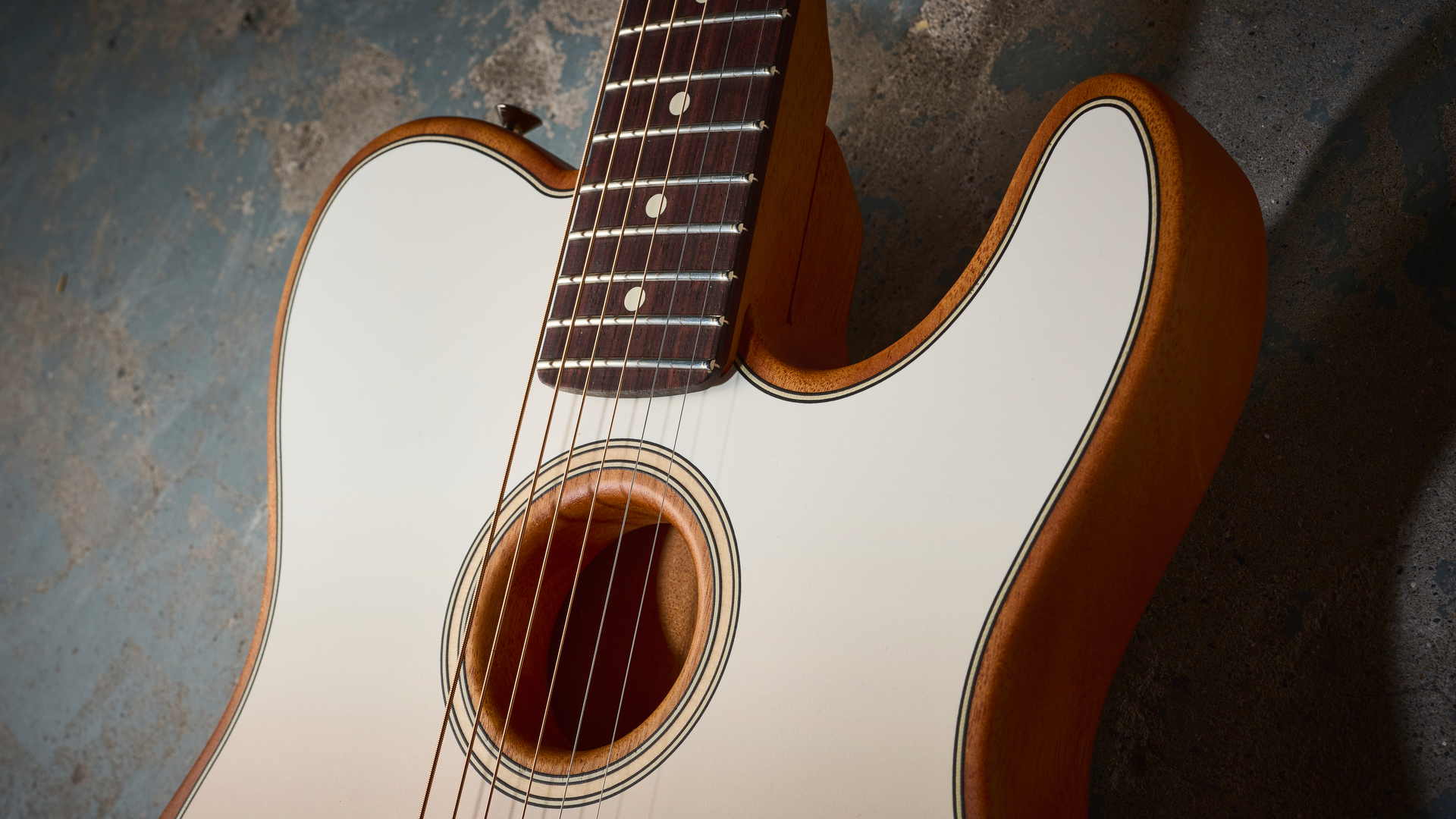
I'll cut to the chase here, I have some mixed feelings about the Cappuccino Fade finish of the Acoustastonic inlay that covers most of this Tele’s top. The transition from white to Cappucino is slightly more abrupt than I hoped and is less forgiving (read: a little more yellowish) at some angles in daylight than the press pics suggest.
However, that’s the thing about guitar finishes isn't it; one player’s Sunburst is another’s… You get the point. It’s not unappealing, and more of the golden blend comes through under lower artificial light, but it might put some people off – as aesthetic elements can do. Fender might have missed a trick when they didn’t design Acoustasonics with interchangeable fascias in mind…
Elsewhere, it’s a fine example of an Acoustasonic Player Tele; a guitar tasked with winning a wider customer base in 2022 after two years of pricier US models. Though it lost some of the acoustic voice options, the Player series actually brought a preferred change with a 9-volt replaceable battery power setup for its active circuitry. This was in place of the rather impractical internal rechargeable battery of the American Acoustasonic models (including the Californian-made Ltd Edition Satin Arctic White Finneas Acoustasonic that’s released alongside this guitar) that can't be swapped out in a gigging situation if you run out of juice and has to be charged via a USB cable.
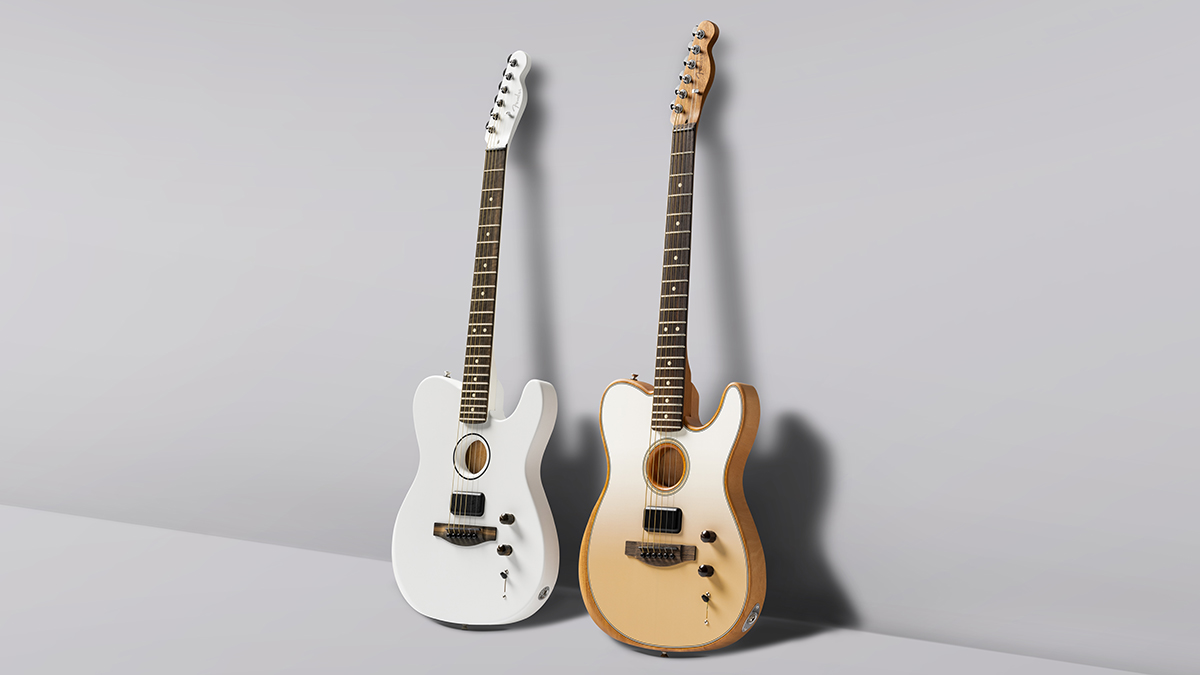
There’s been continued debate about who the Acoustasonic is aimed at – and the answer could be anyone who likes the idea of electric-style playability and form for their amplified electro-acoustic sounds. Players who are perhaps less inclined to see guitars as unique, mystical mojo-delivering vessels and more as tools that need to aid live practicality and the creative process.
For Finneas that need from his Acoustasonics extends from the studio to the stage. For the rest of us, the home is also an area of focus, as I’ll explain later.
Though the neck is a Modern C found on Fender Player electric guitars, it’s a ‘Deep’ version of the carve, compared to the more conventional neck found on the electric Telecaster Player II model. The satin urethane finish on the back is still hugely appealing; a combination of smoothness and grainy goodness that just feels right.
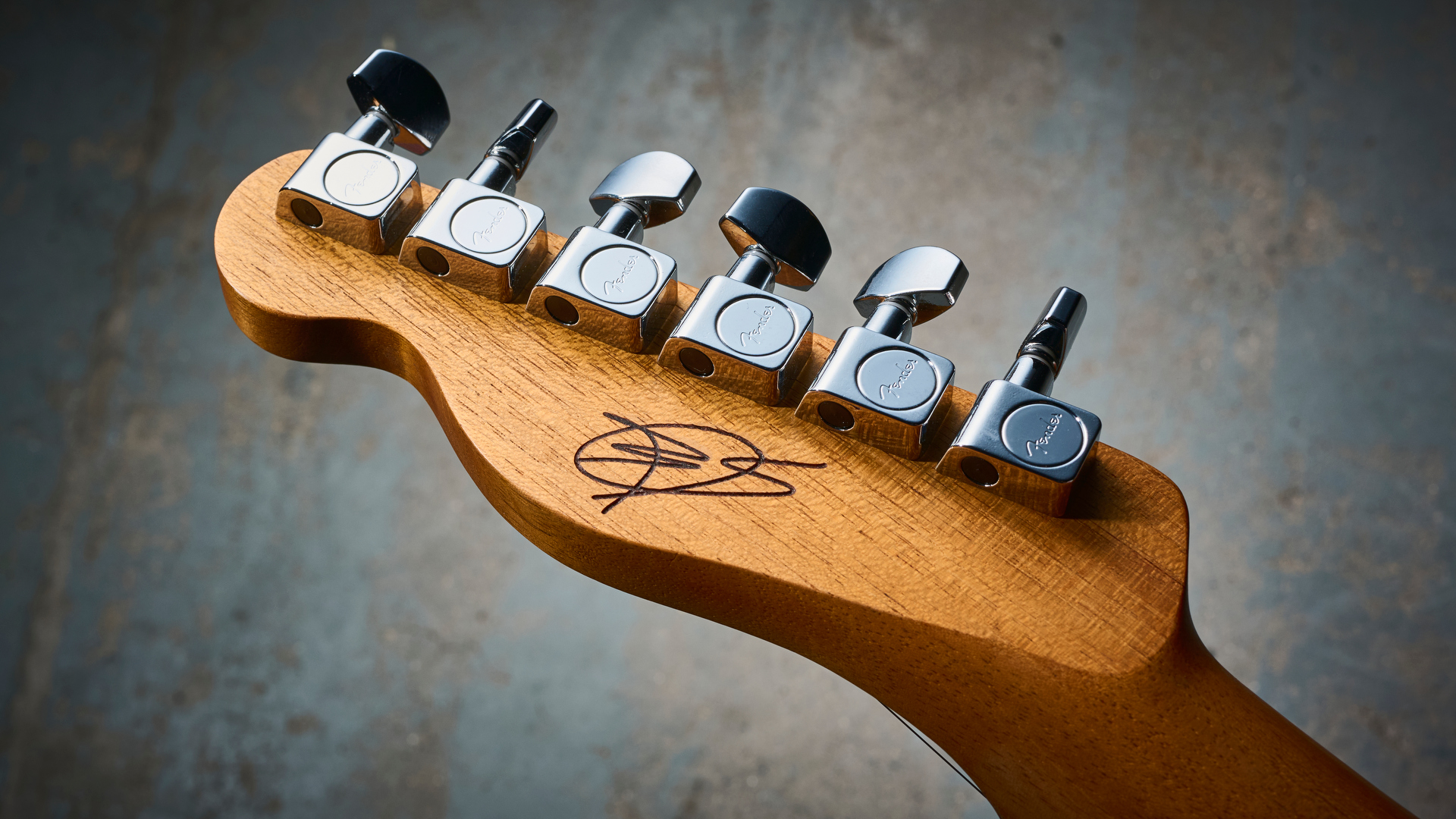
The body shape here is obviously the familiar Tele outline and control layout that’s been proved right for decades, with the ‘Waterfall’ soundhole design of the series' Stringed Instrument Resonance System that left some purists aghast when the American version of the Tele became the launch Acoustasonic in 2010. It delivers a decent amount of acoustic output from a body of this size, though nothing in the realm of a traditional flat-top steel-string.
Fender FINNEAS Acoustasonic Player Telecaster: Playability
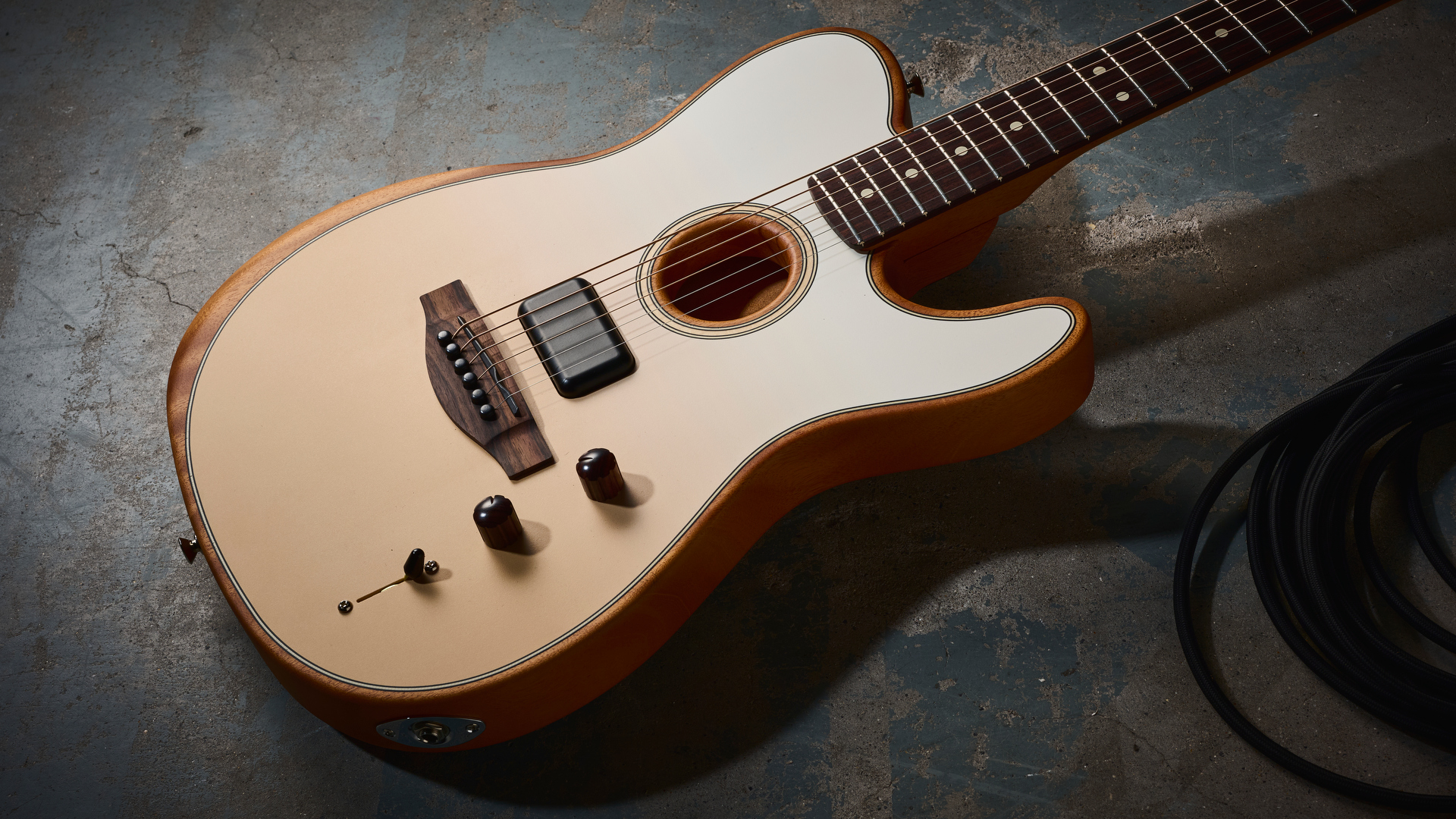
With no individual saddles and an asymmetrical acoustic bridge design you’d be forgiven for thinking you're stuck with the stock action from the factory unless you get the sandpaper out on the saddle or call a tech. But the revival of Fender’s ‘70s Micro-Tilt feature allows you an adaptable shim to alter the guitar's neck angle (accessed via a small hex key in the neck plate after you loosened the rear two neck bolts).
In my experience with the US and Mexican-made Acoustasonics I’ve reviewed in the past, this underrated feature allows for a lot of leeway in tweaking the action. I’ve managed to get it surprisingly low. With no uneven frets significant enough to spoil my fleet-fingered fun!
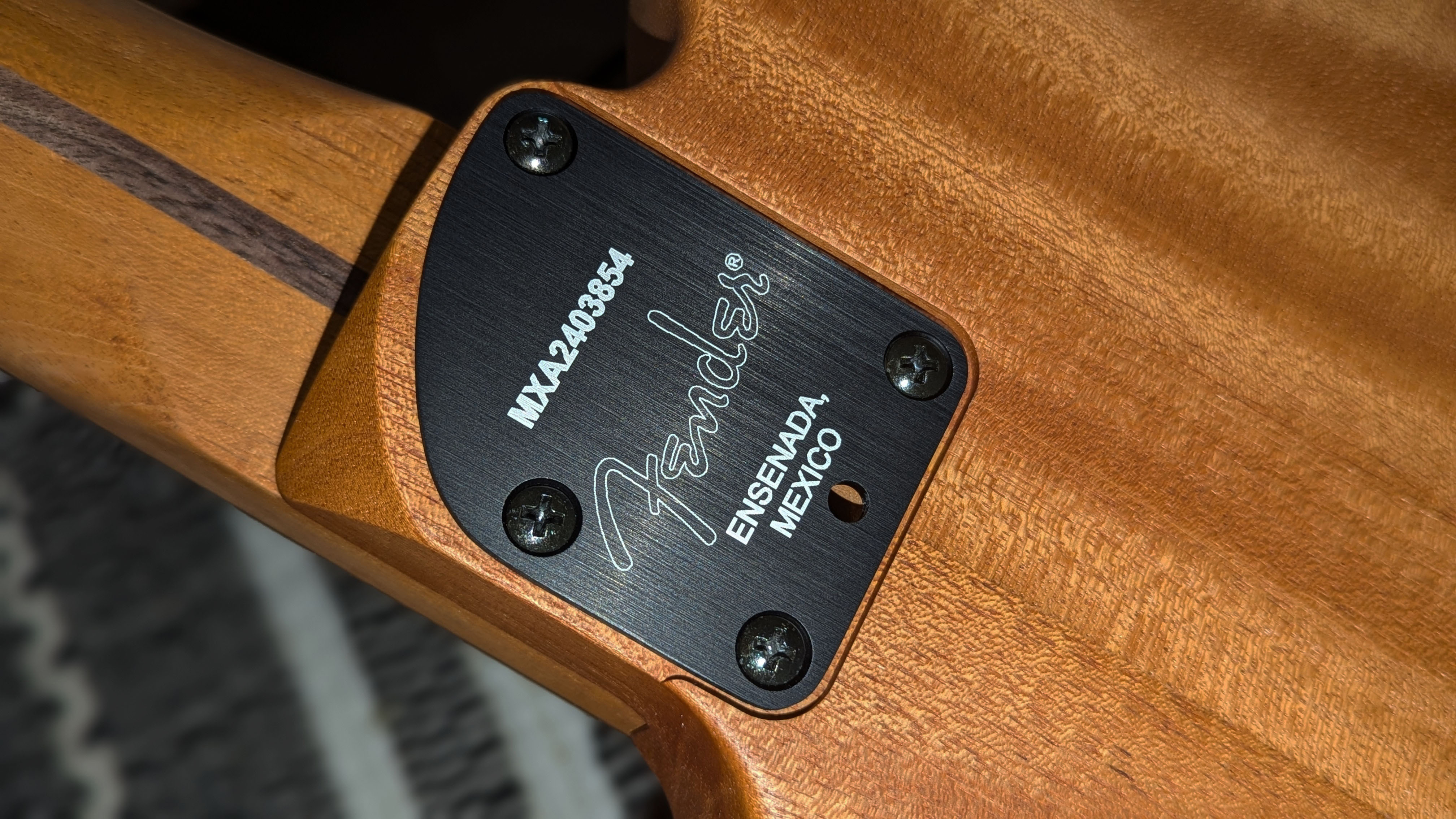
I’ve found Acoustasonics are addictive house guitars – an acoustic with electric accessibility that’s just so easy to pick up and play on the couch, without some of the louder projection that might annoy others around me. And that’s very much the case here, but with it’s boxy unplugged output, it’s a pretty pricey luxury to only use it that way. I’m intrigued as to how Finneas’s spec pans out in this new spin on the Tele model.
Fender Finneas Acoustasonic Player Telecaster: Sounds
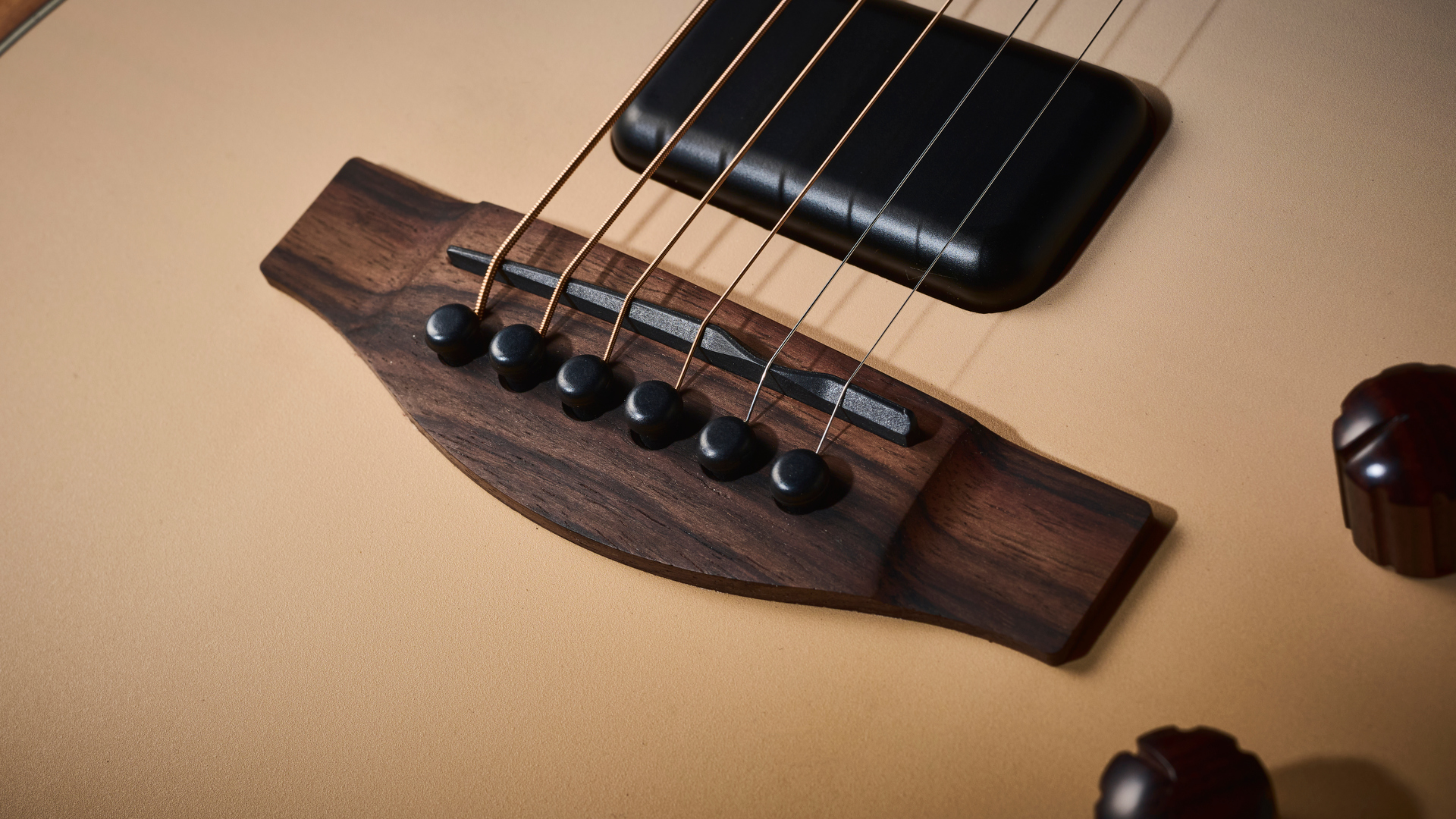
Again, I’ll cut to it – the 'Lo-Fi' sounds have consistently been the least essential Acoustasonic voices in my experience, whether American or Player model. A gnarlier piezo tone is often the very thing I’m trying to get away from with amplified acoustic guitars – it can be too brittle despite the advantages of cutting through in the mix. So on paper, an extra sound to dial in some more ‘realistic’ acoustic timbre with the piezo is appealing here, especially as two of those voices allow me to blend in chorus too.
In addition, the comparatively girthier charms of Acoustasonic Shawbucker that debuted on the Jazzmaster model, are another trade I’m happy to see over the original Tele Player model's single-coil offering. Though that model did offer the choice to blend in an overdriven voice, it's now chorus that can be added.
The bigger question mark that hovers over the Acoustasonic is amplification
And so it proves that this is the most appealing combination of sounds I’ve heard on an Acoustasonic Player model to date – but there are still caveats. Would I like the American model’s body sensor pickup for an even more ‘acoustic’ feel with percussive potential? Absolutely, but that’s currently reserved for the significantly pricier Californian models.
The bigger question mark that hovers over the Acoustasonic is amplification. Its multi-purpose strengths can also be a double-edged sword, as my testing reminds me.
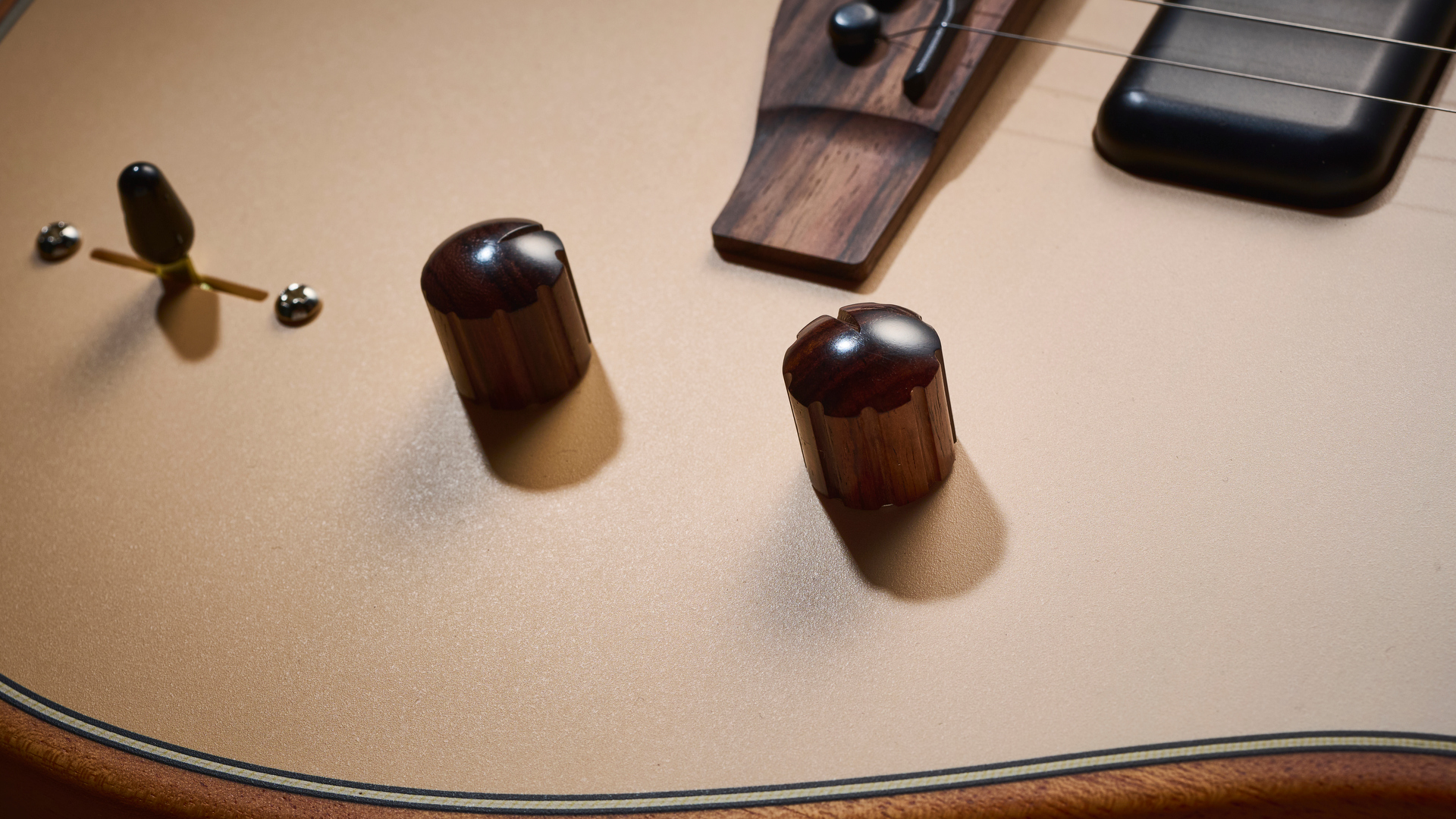
There’s a lot to consider when it comes to how an Acoustasonic guitar can be employed; I am using an FRFR Line 6 Power Cab 112 to simulate a PA, a Fender Deluxe Reverb for a guitar amp, with a selection of overdrive, reverb and delay pedals to explore this hybrid guitar's versatility. In addition, I’m also running the Finneas Acoustasonic Fender Player Telecaster into GarageBand via a Universal Audio Volt 1 audio interface to try out the kind of DI experience Finneas has used his Acoustasonics for.
The best case scenario is using the Acoustasonic Shawbucker pickup through a guitar amp, and the piezo voices through a full-range/flat-response cab to capture more of their detail. That scenario kind of flies in the face of the idea that this guitar can switch effortlessly between acoustic and electric voices, but it still can pull hybrid duties, it’s just you’ll have to compromise getting the best frequency response for each specific pickup source.
One way to get the better of both worlds is using a pedal amp and IR on for the Shawbucker position and switch it off through an FRFR speaker or PA for the acoustic voices, then you’ll still need to boost the signal for the flat response side so the transitions aren't too abrupt – not exactly seamless switching. However, there are no rules to how you use this guitar…
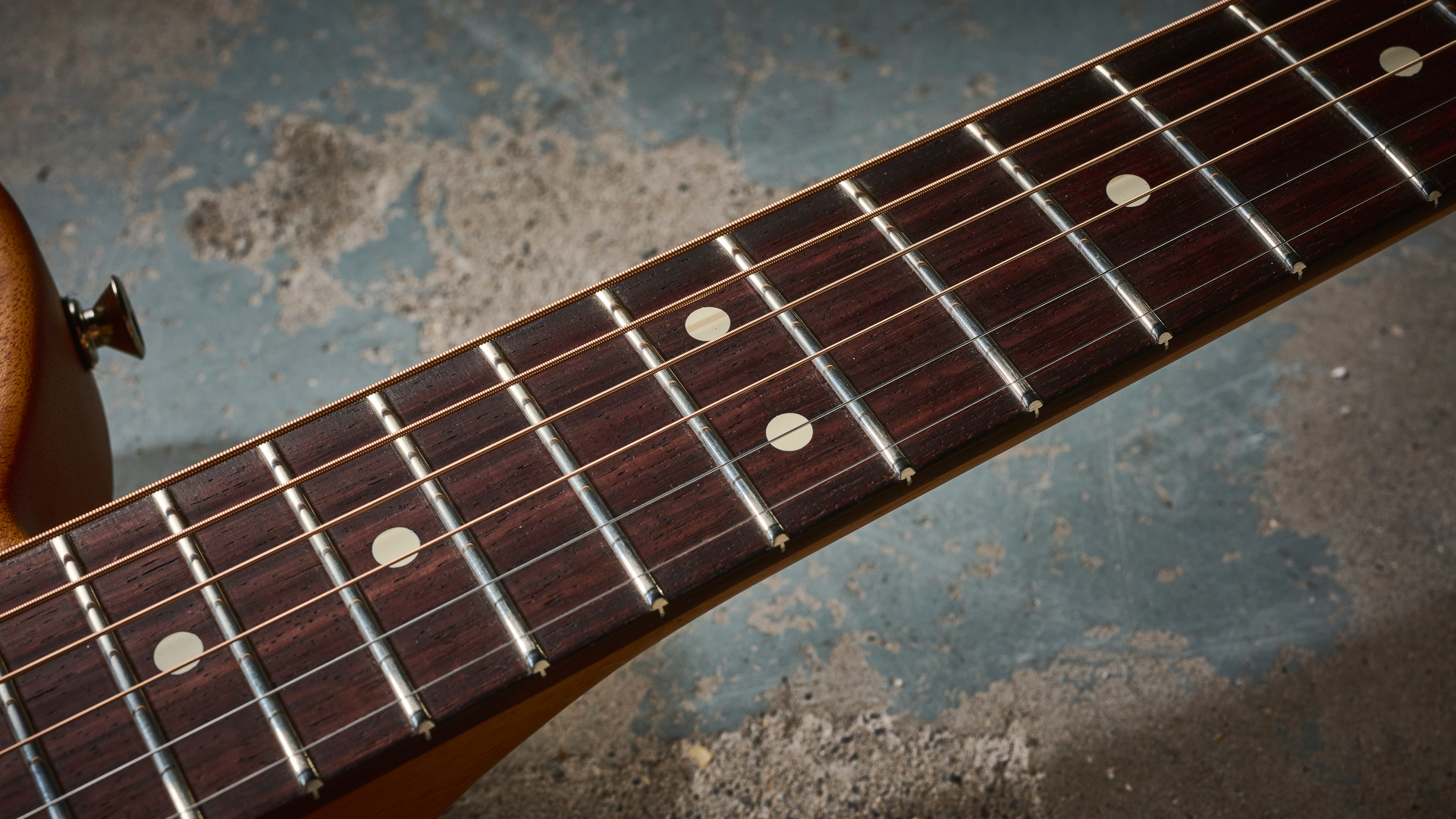
I prefer the low-end response of the Shawbucker here over the standard Acoustasonic Tele Player model pickup, and it feels less of an abrupt switch with the piezo voices. Especially as you can switch from positions 1 to 3 with the same chorus blend offering some consistency.
For someone who isn’t a fan of chorus on acoustics unless I’m playing ‘80s power ballads, Finneas has shown me he’s on to something with this
It’s important to stress to newcomers that this is a fourth-generation Fender noiseless pickup designed for an electric voice for this particular acoustic guitar, rather than the more dynamic response and output of a traditional electric guitar humbucker. And unlike an electric guitar, the volume control here can’t dial down your gain either – it simply turns the whole output down.
For someone who isn’t a fan of chorus on acoustics unless I’m playing ‘80s power ballads, Finneas has shown me he’s on to something with this. Dialled in just under halfway on the blend knob (you’ll have to guess as there’s no markers, which I think would be useful on this control) you can add some movement and sustain to parts, without going full Purple Rain. But even at full it’s a tasteful dose of modulation that’s bright enough to pop in a mix and light enough rate to veer short of tacky.
The scope widens with the middle position voices – a rosewood dreadnought and mahogany small-body that can be switched to position 3’s mahogany dreadnought with chorus for an instant change of texture. The rosewood dread' has the biggest, bass-heavy tone here that I think is best suited to solo performance, whereas the mid-cut of the mahogany-based voices could work better in a band mix through a PA or FRFR cab.
Fender Finneas Acoustasonic Player Telecaster: Verdict

There are players who will never be sold on the Acoustasonic idea, and that’s fine – there are people who don’t like Les Pauls and Strats too. But this is the most useful mix of sounds I’ve heard on the Player side of the line. Especially for solo artists looking to expand their sounds without a pedalboard.
If I have one consistent concern with the Acoustasonic project, it’s the price
Outside of recording studios and in the wider market, the conversation about Acoustasonics as a recording tool has felt a little niche. Why go direct when you can mic a proper acoustic? Well, going direct and speeding up the workflow for demoing and even layers in the final tracking has long been a thing – and is becoming more prevalent with a generation of artist/producers less tied to the conventions of genre and traditions on how guitar tones should be generated. The direct sounds are indeed pretty good here too – and so much easier than setting up a condenser mic in a less-than-ideal room and waiting for the traffic outside to die down. Add in some compression and amp plugins, and the scope widens further.
If I have one consistent concern with the Acoustasonic project, it’s the price. On the one hand, it is what it is - some models are beyond budgets. We know we don't have access to everything. The cost of entry is not about to go down for an Acoustasonic, despite murmurings a couple of years ago. The manufacturing process is more involved than Fender’s Player electrics but it seems a real shame to me that the younger generations who might be the most open-minded to this hybrid guitar are probably priced out of it.
As it stands this costs $200 more than the standard Player Telecaster; $1,400 is not an affordable guitar. Whether it’s worth the extra will, for those looking to invest in a Acoustasonic Player Telecaster, rest on the appeal of the chorus effect and the Finneas finish, but the Shawbucker is certainly a sweetener.
Final verdict: The inclusion of onboard chorus and more acoustic variety in place of the brasher piezo tones of previous Player Acoustasonic models proves an appealing combination here – but it still comes at a relatively high entry price, especially for younger players.
Fender Finneas Acoustasonic Player Telecaster: Also try
($1,199/£979/€1,139)
No blendable chorus here and a single-coil magnetic noiseless pickup, but you get two acoustic model voices, lo-fi piezo and the option to have an overdriven magnetic voice.
Read our review
($1,699/£1,639)
There are no electric guitar dimensions or playability to be found here on this latest TransAcoustic, but in addition to onboard chorus that can be heard through the soundhole, there's reverb, delay, a looper and Bluetooth audio streaming.
($1,599)
The acoustic pickup expert turns its hand to forward-thinking guitar design with a slim profile and a focus on acoustic sounds via the company's HiFI Duet system that combines a bridge plate sensor with a Silo mic.







